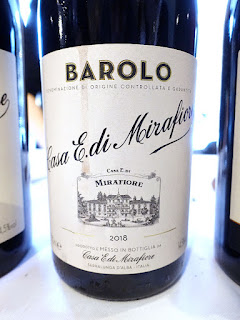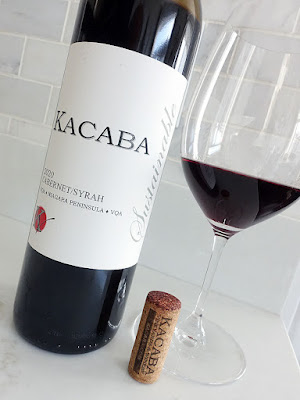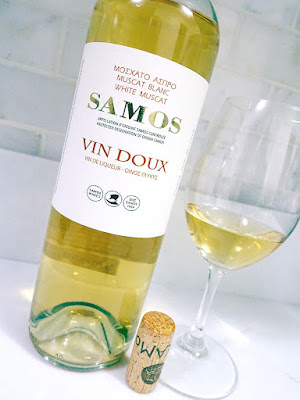red wine review is a lovely Pinot Noir from Burgundy that was a new arrival at the LCBO in December. It was included as part of the theme of "Fine Wines for Festive Entertaining" in the LCBO VINTAGES New Release Collection and would be a fine match for upcoming family feasts, with the added bonus that it's on clearance right now, with plenty of bottles still available for purchase.
It is produced by the prestigious and historic Maison Albert Bichot. The first traces of the family name date back to 1214, while in 1350 they settled in Burgundy, France. The Bichot family's coat of arms - a doe (biche) - was established in the 14th century and has not changed since. In 1831, Bernard Bichot founded a wine trading business in his name in Monthélie, while his son, Hippolyte, succeeded him and bought the first vines in Volnay. Hippolyte's son, Albert Bichot, the first to bear the name, gave the family business new momentum in the late 19th century and settled in the centre of Beaune in 1912.
Born in 1900, the second Albert Bichot was a pioneer of international commerce and travelled the globe to introduce the family's wines, which were already recognized as being among the best. During the second half of the 20th century, Albert's four sons - Albert, Bernard, Bénigne, and Jean-Marc - inherited the family business and know-how, and a new era of expansion with the construction of a large cellar, bottling facility, and winery.
In the early 1990s, Albéric Bichot, the son of the third Albert, joined the family company and took over its management in 1996. Though he fully respects long-held family traditions, he is completely focused on the future. He compares himself to the conductor of an orchestra and is proud to bring people and their talents together over a common project. Albéric has numerous challenges, such as converting to organic viticulture in the Côte-d'Or vineyards, ongoing adaptation to new markets, and increasing the prestige and exposure of Burgundy wines, but he is convinced that the quality of the wine is dependent on the quality of the grapes. Thus, he is focused on developing control of grape growing, a task that began in the 1980s. Albéric also secured equipment, expanded vinification capacity, and the ageing cellars, while the company's vineyards now total 6 estates that are spread out across Burgundy from the north to the south.
Today, the philosophy at Albert Bichot is based on protecting their children's planet, and respect for the terroir and nature. They practice sustainable viticulture based on observation, prevention, and being attentive to the complex balances found in nature. The soil is maintained responsibly, while encouraging manual labour that boosts the plants’ natural defences. Bichot also follows up on their partners' grower plots with the same thoroughness and philosophy as their own. At the winery, they apply a minimal interventionist approach during the vinification process so that the wines reveal the terroir and characteristics of the village where they hail from. The wine is carefully transferred from the vinification vats or barrels to the cellars by means of gravity. It is during the key period, while in the cellar, that time and expertise come together, and the wines truly acquire their body, reveal their personality, and all of their potential.
Crafted with 100% Pinot Noir, this red wine was grown in the village appellation of Saint-Romain, in the central part of Côte de Beaune, Burgundy. The appellation is situated in an isolated valley to the north of the Cote d'Or's main escarpment and stands at the foot of a high cliff, but at an elevation which enables it to look out over a wide stretch of the countryside. While bears and lions roamed here 100,000 years ago, the area has been a focus of human activity since neolithic times. The area was one of the first places in Bourgogne where the Celts and Gallo-Romans cultivated vines, and eventually led to Saint-Romain being instituted as an appellation in 1947. The terroir in Saint-Romain can be traced back to the earliest period of the Jurassic, with the soil consisting of a blend of limestone and marl, with patches of clay. The vines in Saint-Romain, which face south-southeast and north-northeast at altitudes between 280 and 400 metres, occupy a sloping site where they benefit from the excellent soil. The Pinot Noir vines used to craft this wine were grown in brown limestone soil. It was vinified in oak barrels (20% new) for 6 to 8 weeks, and remained in oak barrels (25% new) for 14 to 16 months to maturation.
The 2018 growing season was noted for being one of the hottest and driest growing seasons since the intense heatwave of 2003. Despite a wet winter and spring, perfect weather arrived in time for an early, but very successful flowering. Summer was hot and exceedingly dry, followed by ideal conditions arriving in August and September, which meant that producers could harvest their grapes at their own leisure. From an excellent vintage, let's see how this 2018 Pinot Noir from Burgundy is tasting tonight...
$41.95 $34.75
From the Saint-Romain village appellation of Côte de Beaune, this Pinot Noir has a perfumed, medium+ to medium-high intensity nose that offers a lovely bouquet of rose floral, sweet spices, ripe red & black cherry, earthy mineral, and mushroom aromas. It's light-to-mid weighted with good structure and fine, crisp, and tangy acidity that supports the ripe red & black cherry, gentle oak spice, and earthy mineral flavours with touches of beetroot. The light tannins have a subtle, chalky textured grip. Earthy mineral notes linger on the finish, with excellent length. Highly recommended buy! Score: 91+ pts
Other fine wines by Maison Albert Bichot are available at the LCBO and through their Agent - Dionysus Wines & Spirits.
It is produced by the prestigious and historic Maison Albert Bichot. The first traces of the family name date back to 1214, while in 1350 they settled in Burgundy, France. The Bichot family's coat of arms - a doe (biche) - was established in the 14th century and has not changed since. In 1831, Bernard Bichot founded a wine trading business in his name in Monthélie, while his son, Hippolyte, succeeded him and bought the first vines in Volnay. Hippolyte's son, Albert Bichot, the first to bear the name, gave the family business new momentum in the late 19th century and settled in the centre of Beaune in 1912.
Born in 1900, the second Albert Bichot was a pioneer of international commerce and travelled the globe to introduce the family's wines, which were already recognized as being among the best. During the second half of the 20th century, Albert's four sons - Albert, Bernard, Bénigne, and Jean-Marc - inherited the family business and know-how, and a new era of expansion with the construction of a large cellar, bottling facility, and winery.
In the early 1990s, Albéric Bichot, the son of the third Albert, joined the family company and took over its management in 1996. Though he fully respects long-held family traditions, he is completely focused on the future. He compares himself to the conductor of an orchestra and is proud to bring people and their talents together over a common project. Albéric has numerous challenges, such as converting to organic viticulture in the Côte-d'Or vineyards, ongoing adaptation to new markets, and increasing the prestige and exposure of Burgundy wines, but he is convinced that the quality of the wine is dependent on the quality of the grapes. Thus, he is focused on developing control of grape growing, a task that began in the 1980s. Albéric also secured equipment, expanded vinification capacity, and the ageing cellars, while the company's vineyards now total 6 estates that are spread out across Burgundy from the north to the south.
Today, the philosophy at Albert Bichot is based on protecting their children's planet, and respect for the terroir and nature. They practice sustainable viticulture based on observation, prevention, and being attentive to the complex balances found in nature. The soil is maintained responsibly, while encouraging manual labour that boosts the plants’ natural defences. Bichot also follows up on their partners' grower plots with the same thoroughness and philosophy as their own. At the winery, they apply a minimal interventionist approach during the vinification process so that the wines reveal the terroir and characteristics of the village where they hail from. The wine is carefully transferred from the vinification vats or barrels to the cellars by means of gravity. It is during the key period, while in the cellar, that time and expertise come together, and the wines truly acquire their body, reveal their personality, and all of their potential.
Crafted with 100% Pinot Noir, this red wine was grown in the village appellation of Saint-Romain, in the central part of Côte de Beaune, Burgundy. The appellation is situated in an isolated valley to the north of the Cote d'Or's main escarpment and stands at the foot of a high cliff, but at an elevation which enables it to look out over a wide stretch of the countryside. While bears and lions roamed here 100,000 years ago, the area has been a focus of human activity since neolithic times. The area was one of the first places in Bourgogne where the Celts and Gallo-Romans cultivated vines, and eventually led to Saint-Romain being instituted as an appellation in 1947. The terroir in Saint-Romain can be traced back to the earliest period of the Jurassic, with the soil consisting of a blend of limestone and marl, with patches of clay. The vines in Saint-Romain, which face south-southeast and north-northeast at altitudes between 280 and 400 metres, occupy a sloping site where they benefit from the excellent soil. The Pinot Noir vines used to craft this wine were grown in brown limestone soil. It was vinified in oak barrels (20% new) for 6 to 8 weeks, and remained in oak barrels (25% new) for 14 to 16 months to maturation.
The 2018 growing season was noted for being one of the hottest and driest growing seasons since the intense heatwave of 2003. Despite a wet winter and spring, perfect weather arrived in time for an early, but very successful flowering. Summer was hot and exceedingly dry, followed by ideal conditions arriving in August and September, which meant that producers could harvest their grapes at their own leisure. From an excellent vintage, let's see how this 2018 Pinot Noir from Burgundy is tasting tonight...
Tasting Note:
BICHOT SAINT-ROMAIN PINOT NOIR 2018 - AC, Burgundy, France (#33708) (XD) -From the Saint-Romain village appellation of Côte de Beaune, this Pinot Noir has a perfumed, medium+ to medium-high intensity nose that offers a lovely bouquet of rose floral, sweet spices, ripe red & black cherry, earthy mineral, and mushroom aromas. It's light-to-mid weighted with good structure and fine, crisp, and tangy acidity that supports the ripe red & black cherry, gentle oak spice, and earthy mineral flavours with touches of beetroot. The light tannins have a subtle, chalky textured grip. Earthy mineral notes linger on the finish, with excellent length. Highly recommended buy! Score: 91+ pts
Other fine wines by Maison Albert Bichot are available at the LCBO and through their Agent - Dionysus Wines & Spirits.





















